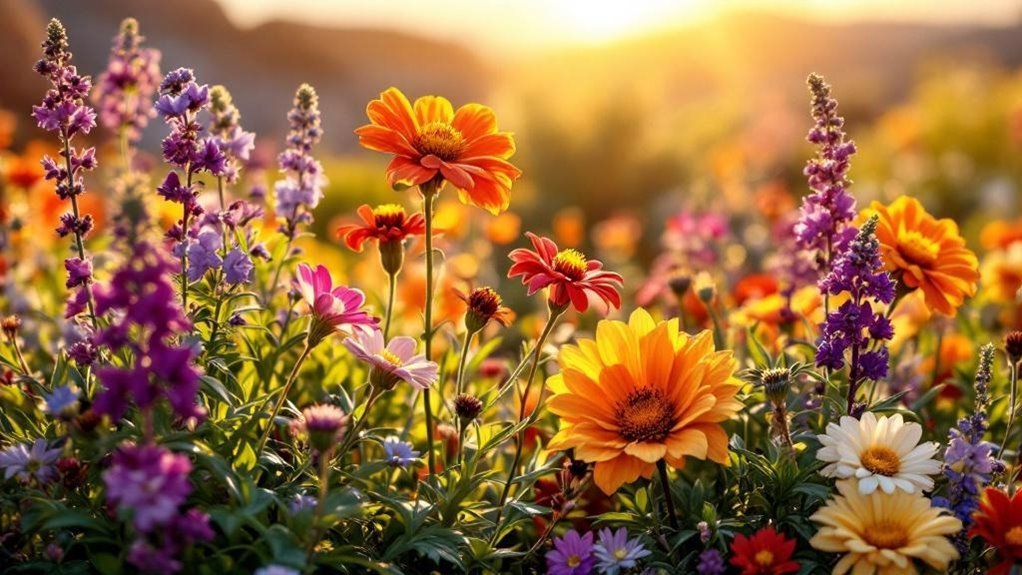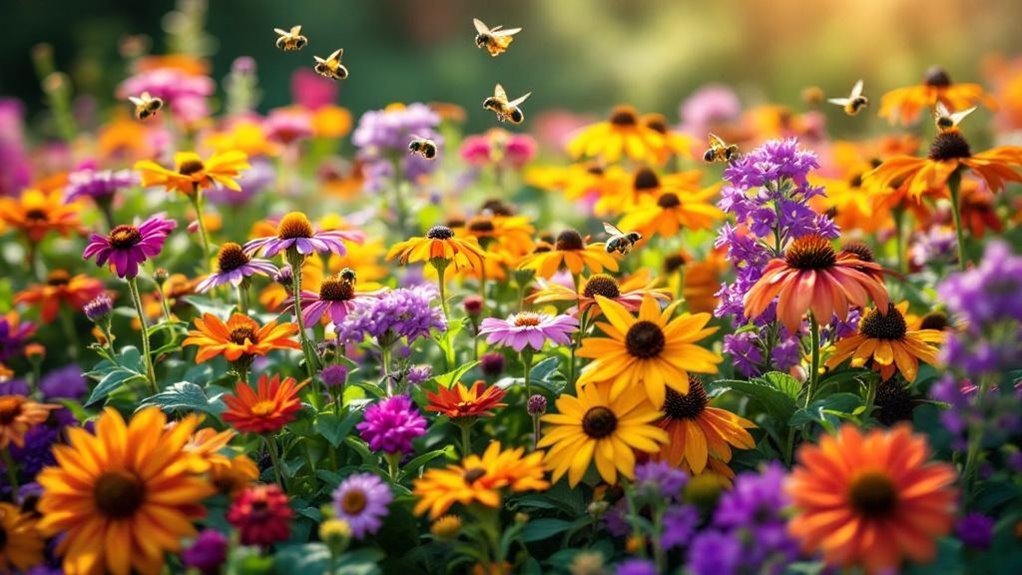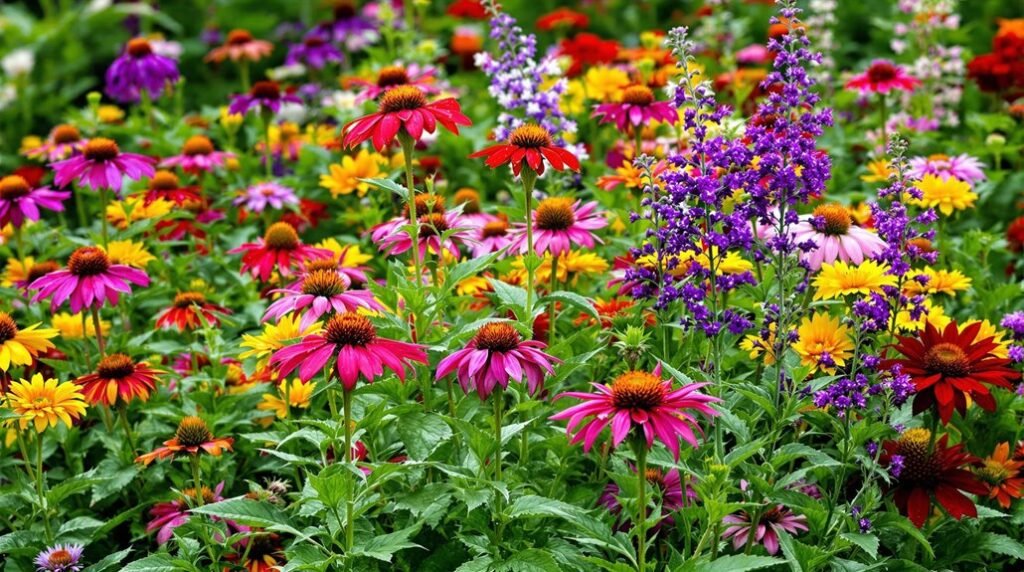You might be surprised how a carefully chosen mix of perennial flowers can keep your garden vibrant from early summer well into fall. By selecting varieties that bloom at different times and thrive in your specific conditions, you’ll enjoy a seamless display of color. But which perennials offer the best combination of continuous bloom, low maintenance, and appeal to pollinators? Let’s explore the top options that make this possible.
Top Perennials for All-Season Color
If you want your garden to burst with color all season long, choosing the right perennials is key.
Black-eyed Susan and Coreopsis are long-blooming perennials that thrive in full sun and bloom from summer to fall, adding vibrant yellow hues that brighten any space.
Black-eyed Susan and Coreopsis bloom vibrant yellow from summer to fall, brightening sunny gardens beautifully.
Daylilies offer a variety of colors and often rebloom, giving your garden continuous interest.
Garden Phlox, with its fragrant clusters, attracts butterflies and adds lovely pinks and purples.
Catmint’s lavender-blue flowers are easy to grow and drought-tolerant, providing steady color while drawing beneficial pollinators.
These perennials aren’t only beautiful but also low-maintenance, making them perfect for gardeners wanting reliable, season-long blooms.
Incorporate these plants, and you’ll have a lively, colorful garden that butterflies love throughout the warmer months.
Sun and Soil Requirements for Healthy Growth
Although perennial flowers vary in their sun and soil preferences, you’ll find that most thrive in well-drained soil and require adequate sunlight to bloom vibrantly.
Sun exposure is key; many perennials that bloom best need full sun to part shade, though some like garden phlox tolerate partial shade.
Understanding soil moisture levels is important—while drought tolerant varieties like yarrow prefer dry conditions, others need medium moisture for healthy growth.
Pay attention to your USDA Hardiness Zones to select perennials suited to your climate.
To support continuous bloom time, maintain soil health with regular soil amendments, improving drainage and nutrient availability.
Drought-Tolerant Perennials That Thrive

When you choose drought-tolerant perennials, you guarantee your garden stays vibrant even during dry spells.
Perennials like Yarrow and Black-Eyed Susan thrive in USDA Hardiness Zones 3 to 9, offering yellow flowers that bloom continuously through summer and attract butterflies.
Yarrow and Black-Eyed Susan bloom all summer, thriving in Zones 3 to 9 while attracting butterflies.
Russian Sage and Catmint add lavender-blue hues and attract pollinators while being low maintenance.
Ice Plant thrives in Zones 5 to 10 with striking red-purple blooms, perfect for sunny, well-drained spots.
These drought-tolerant perennials need little water once established, making them ideal for gardeners seeking continuous bloom with minimal effort.
Long-Blooming Varieties to Extend Your Garden’s Beauty
To keep your garden vibrant from spring through fall, choose long-blooming perennials like Coreopsis Daybreak and Black-Eyed Susan that provide continuous color and attract butterflies.
These long-blooming perennials are perfect for a summer garden, offering cheerful hues and extended blooms. Coreopsis shines with bright yellow flowers that attract butterflies, while Black-Eyed Susan delivers daisy-like blooms that encourage more flowering with regular deadheading.
You can also add Daylilies, known for their reblooming varieties, to extend garden color from late spring to fall. Catmint brings lavender-blue flowers and fragrant clusters, thriving with minimal care and further enhancing your garden’s appeal.
Attracting Pollinators With Vibrant Perennials

Since vibrant perennials provide essential nectar, choosing plants like Coneflower and Black-Eyed Susan will attract butterflies and bees to your garden.
Vibrant perennials like Coneflower and Black-Eyed Susan offer vital nectar to attract butterflies and bees.
When attracting pollinators, the key is to include a variety of brightly colored flowers with different bloom times.
Consider these top choices:
- Bee Balm and Butterfly Bush – Their striking flowers bring hummingbirds and butterflies from late spring through fall.
- Catmint and Yarrow – Low-maintenance perennials that offer lavender-blue to bright yellow blooms, attracting bees and thriving in diverse conditions.
- Common Bleeding Heart and Garden Phlox – These add unique shapes and scents, enhancing your garden’s appeal to pollinators throughout the season.
Frequently Asked Questions
What Perennial Flower Blooms All Summer Long?
If you want a perennial that blooms all summer long, you’ll love catmint. It continuously flowers from late spring through fall, attracts pollinators, and needs little care, making your garden vibrant with minimal effort.
What Flower Blooms Constantly?
Did you know some reblooming daylilies can flower continuously from late spring to fall? You’ll love how they brighten your garden nonstop, ensuring a vibrant, ever-changing display without needing constant replanting or fuss.
Are There Flowers That Stay Bloomed All Year?
You won’t find flowers that bloom all year naturally since most plants have resting periods. However, with indoor conditions or tropical plants, you can enjoy nearly continuous blooms if you provide the right light, temperature, and care.
How Do I Encourage Continuous Blooming?
Want nonstop blooms? Just talk sweetly to your plants, then deadhead spent flowers, divide perennials regularly, fertilize heavy feeders, and plant a mix of early to late bloomers—you’ll have a floral fiesta all season long!
Final Thoughts
By choosing the right perennials, you’re not just planting flowers—you’re creating a vibrant, ever-changing masterpiece. Imagine your garden bursting with color from early summer through fall, attracting butterflies and hummingbirds at every turn. But here’s the secret: the key to continuous bloom lies in picking varieties that suit your soil, sun, and water conditions perfectly. Ready to release your garden’s full potential? The best blooms—and the busiest pollinators—are just waiting for you to start.
